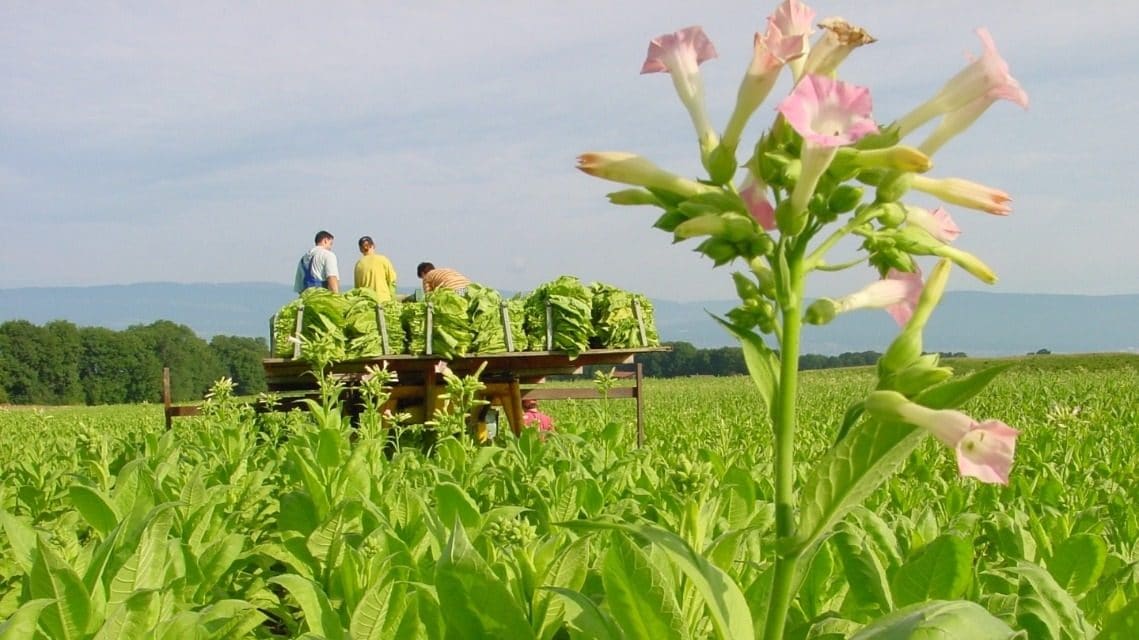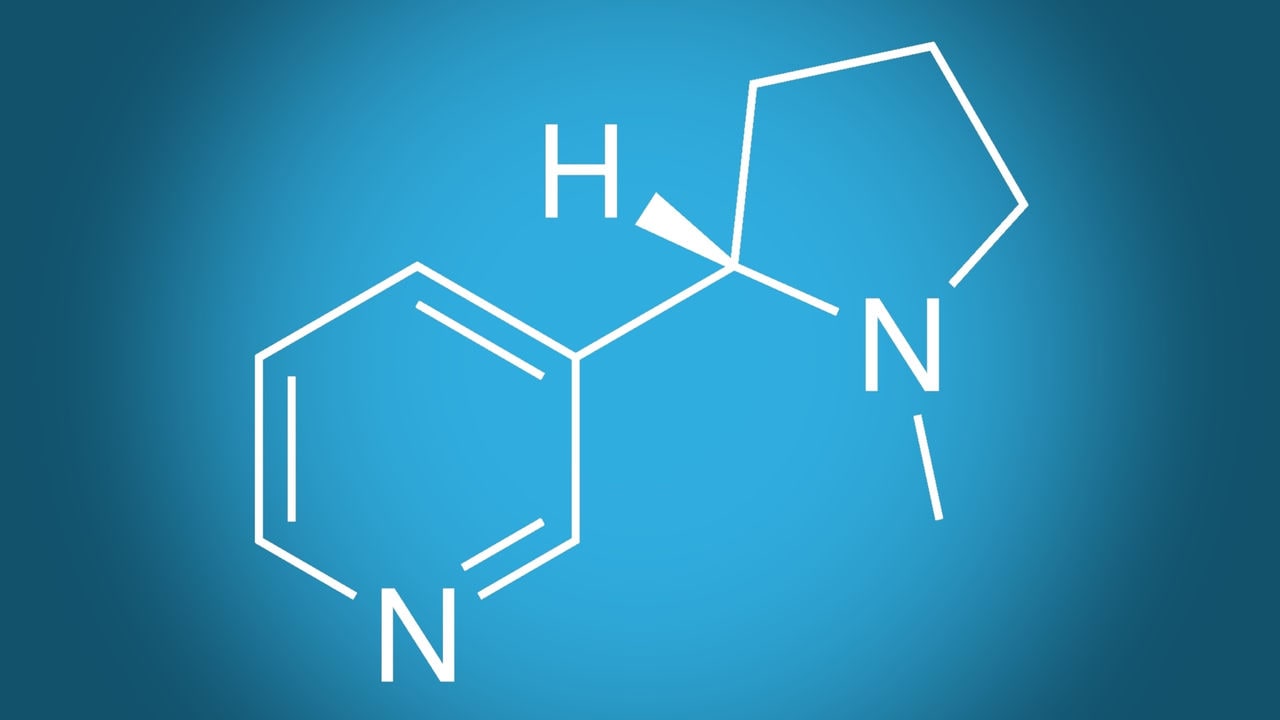Genetic tree showing the relationships between 567 different tobacco varieties. The circular format enables the representation of many varieties in one image. The tips of the tree, at the outer rim of the circle, represent the different varieties. The nodes towards the center represent common ancestors, each in a different color signifying the different types. The branches that are closest together are the most related. Click on the image to zoom in.
Tobacco plant research, yesterday, today, and tomorrow
The Nicotiana family tree
The tobacco plant belongs to the Nicotiana genus, a member of the Solanaceae (nightshade) family which includes tomato, bell pepper, and potato. Most commercial tobaccos belong to the species N. tabacum, of which there are over 1,600 varieties, sometimes classified into commercial types.
The genomes of the three most cultivated types of tobacco plants, namely Virginia (or Flue-cured), Burley, and Oriental, have been sequenced by PMI researchers.
N. tabacum has a large complex genome which is allotetraploid, meaning it comprises four sets of chromosomes from two different species (as opposed to most animals which inherit their chromosomes from two parents of the same species). Indeed, N. tabacum is known to have evolved through the hybridization of two ancestral species, N. sylvestris and N. tomentosiformis, about 200,000 years ago. This makes tobacco a relatively young plant in terms of evolution.
The impact of humans on tobacco genetics
Tobacco cultivation first began in the Americas around 6,000 BCE. The arrival of Europeans in 1492 led to a significant growth in the use of tobacco, and by the 19th century, it had become a global industry. Over time, plants were bred to survive on different soils, in different environments, to resist different pests and predators, and to be used in different agricultural practices.
For example, Virginia and Burley were developed in the 19th century in the U.S., while Oriental is a divergent type developed over 300 years in isolated, stressful environments across what is now Greece, North Macedonia, and Turkey (tobacco was introduced to the Ottoman empire in the 16th century). This might explain differences in how they assimilate nitrogen and other compounds. Notably, Burley stands out with its relatively high nitrogen requirement.
The way N. tabacum has evolved to metabolize nitrogen and other compounds has been studied extensively by PMI researchers and others.
Nicotine and other plant defense mechanisms
Tobacco synthesizes several organic compounds known as alkaloids, which includes nicotine, to protect the plant against insects and other pathogens. Mining the N. tabacum genome for sequences related to alkaloid biosynthesis, our researchers found evidence that the expression of genes related to nicotine biosynthesis occurs mainly in the roots, where most alkaloids are synthesized.
While nicotine defends against animal pests and numerous pathogens, it is ineffective against the destructive and widespread plant pathogen known as the tobacco mosaic virus (TMV), which causes leaf mottling, stunted growth, and reduced yield, leading to important economic impact.
TMV was the first virus ever discovered, with Martinus Beijerinck proposing in 1898 the existence of an infectious agent that was neither a bacterium nor a toxin. It has been central to the study of virology—plant, animal, and particularly human—ever since. Rosalind Franklin, most famous for her work on the structure of DNA, published a structure of TMV in 1955 and the virus is currently used by molecular biologists to deliver genetic material into plant cells.
In the 1930s, tobacco breeders defeated TMV by introducing a gene from a resistant Nicotiana species, N. glutinosa, into the Burley genome through hybridization. These days, many commercial Burley and Virginia tobacco varieties carry this resistance gene.
Nicotiana as a model plant
N. tabacum plays an important role as a model organism in plant research. It was used in the 19th century to understand plant hybridization, and since the 20th century to study fundamental plant biology. Nevertheless, only fragmented genomic sequences were available until 10 years ago, when we published high-quality draft genomes for the three main tobacco varieties, Burley (TN90), Virginia (K326), and Oriental (BX). In 2024, we published chromosome-level genome assemblies of N. tabacum and its progenitors, N. sylvestris and N. tomentosiformis, which will broaden our understanding of their contributions to tobacco genetics and enable more efficient synteny-based cross-species Solanaceae research.
Nicotiana is also used in research to examine the vulnerability of commercially important Solanaceae crops to various diseases, including TMV, tobacco vein mottling virus (TVMV), tobacco etch virus (TEV), and potato virus Y (PVY). The Burley tobacco plant has been bred to resist all these infections.
Reducing harmful compounds in tobacco
We routinely monitor harmful and potentially harmful constituents in tobacco. For example, alkaloids in tobacco plants are associated with the generation of harmful tobacco-specific nitrosamines (TSNAs). We have worked extensively to find ways of lowering levels of TSNAs and other harmful compounds in tobacco.
Without doubt the best way to reduce the risk of smoking-related disease is never to start, or for those who smoke, to quit tobacco and nicotine altogether. On our end, we are continuously working on ways to further improve our smoke-free products intended for those adult smokers who don't quit. In these efforts, tobacco plant research can play an important part as well.

The future of tobacco
With our focus on driving the obsolescence of combustible tobacco, the future of tobacco is clearly evolving. Research on the genetics of the tobacco plant is helping further our efforts towards tobacco harm reduction as well as creating new opportunities in plant biology. The raw materials used in our products rely on fertile soil, stable climate conditions, and access to water. As a business with an agricultural supply chain, it is paramount that we take needed steps to protect and preserve the ecosystems where we operate.
Our tobacco supply chain, leaf curing, fertilizer use, and mechanization all add to our carbon footprint. We are relentlessly working toward achieving an absolute reduction in carbon emissions in our tobacco supply chain of 35 percent by 2025 and 50 percent by 2030 versus our 2019 baseline. To deliver on these targets, we seek to decarbonize the tobacco curing process while implementing additional reduction initiatives focused on the use of fertilizer and mechanization.
Our understanding of this crop, which people have grown and used for millennia, continues to expand and promises to keep revealing valuable data for many industries. Our publications library provides the details of our research, and we share literature reviews of our own.

Read the Scientific Update magazine
The Scientific Update magazine is focused on PMI's research and development efforts, milestone studies, industry regulations, and more. View the latest issue, or read the articles online.



